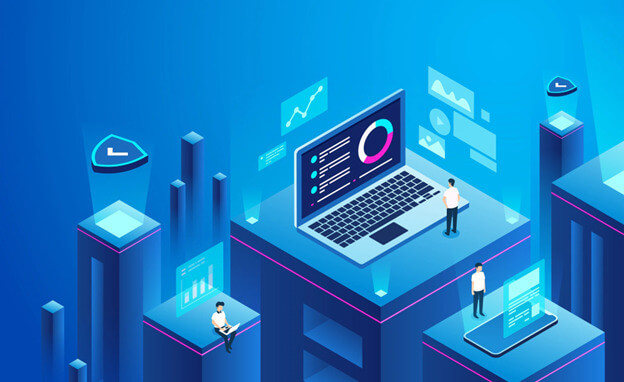The Importance of Information Technology in Our Daily Life

In today’s digital age, Information technology (IT) has become an integral part of our daily lives.
From the moment we wake up until we go to bed, technology surrounds us, simplifying tasks, connecting us with the world, and transforming the way we live, work, and communicate.
In this article, we will explore the numerous ways information technology impacts our lives, making it more convenient, efficient, and enjoyable.
1. Enhancing Communication
Information technology has revolutionized the way we communicate.
With the advent of smartphones, social media, and messaging applications, staying in touch with friends, family, and colleagues has never been easier.
Instant messaging platforms enable real-time communication, bridging the gap between continents and time zones, fostering global connections, and breaking down barriers to communication.
2. Transforming Education
The integration of technology in education has brought about a significant transformation in the learning process.
E-learning platforms, digital textbooks, and educational apps have made knowledge accessible to anyone with an internet connection. Students can now access a vast array of educational resources, engage in interactive learning experiences, and participate in virtual classrooms, expanding their horizons beyond traditional boundaries.
3. Facilitating Information Access
The internet is a vast repository of information and Information Technology has made it possible for us to access this wealth of knowledge instantly. Search engines, like Google, have become an essential tool in our lives, allowing us to find answers to our questions, discover new topics, and explore different perspectives on various subjects.
4. Improving Healthcare Services
Information technology plays a crucial role in enhancing healthcare services.
Electronic health records streamline patient information, making it readily available to healthcare providers.
Telemedicine enables remote consultations and diagnoses, making healthcare accessible to individuals in remote areas.
Medical apps and wearable devices help monitor health conditions, promoting proactive health management.
5. Boosting Business Efficiency
For businesses, Information Technology is a game-changer.

Automation of tasks, data analytics, and cloud computing have revolutionized business operations, leading to increased productivity and cost efficiency.
Digital marketing strategies, powered by IT, have opened up new avenues for businesses to reach their target audiences, expand their customer base, and thrive in the digital marketplace.
6. Revolutionizing Entertainment
Entertainment has evolved tremendously with the advent of Information Technology.
Streaming platforms, online gaming, and virtual reality experiences have redefined how we entertain ourselves.
We can now enjoy movies, TV shows, music, and games on-demand, tailored to our preferences, providing an immersive and personalized entertainment experience.
7. Fostering Innovation
Information Technology fuels innovation across various industries.
From cutting-edge research in science and technology to creative breakthroughs in art and design,
IT provides tools and platforms that inspire and enable progress.
Start-ups and entrepreneurs leverage technology to bring their ideas to life, driving economic growth and societal advancements.
8. Simplifying Daily Tasks
Incorporating Information Technology into our daily routines has simplified many tasks.
From online banking and shopping to smart home devices, technology streamlines mundane activities, saving time and effort.
The convenience of digital calendars, reminders, and productivity apps helps us stay organized and efficient.
9. Strengthening Social Connections
Social media platforms have transformed the way we interact and connect with others.
They allow us to share experiences, ideas, and emotions with a vast audience, strengthening social bonds and creating virtual communities.
Social media has also played a vital role in driving social movements and raising awareness of important issues.
10. Ensuring Global Connectivity
Information Technology has brought the world closer together.
Through video conferencing and collaboration tools, we can work with people from different countries, share knowledge, and foster international cooperation.
This global connectivity promotes cultural exchange, understanding, and unity.
The Importance of Technology in Your Daily Life as a Student
As a student in the 21st century, technology plays a pivotal role in shaping your educational journey and overall daily life.
From accessing information to collaborating with peers, technology has become an indispensable tool that enhances learning, improves efficiency, and opens up new opportunities.

In this article, we will explore the significance of technology in your daily life as a student and how it positively impacts various aspects of your academic and personal experiences.
1. Access to Information
One of the most significant advantages of technology for students is access to a vast amount of information.
With the internet at your fingertips, you can quickly search for academic resources, research materials, and online libraries.
This ease of access enables you to gather information from diverse sources, enriching your knowledge and understanding of various subjects.
2. E-Learning Platforms
Technology has revolutionized the way students learn through the proliferation of e-learning platforms.
These platforms offer interactive courses, video lectures, and digital textbooks, providing flexible and personalized learning experiences. As a student, you can study at your own pace, review materials as needed, and engage with multimedia content to deepen your understanding.
3. Digital Collaboration
Collaborating with peers and teachers has become seamless and efficient with technology.
Online communication tools, such as email, messaging apps, and video conferencing, enable you to interact with classmates and instructors regardless of geographical boundaries.
Digital collaboration fosters teamwork, enhances communication, and encourages knowledge-sharing among students.
4. Productivity and Organization
Technology offers a range of productivity tools that help you stay organized and manage your academic tasks effectively.
Digital calendars, task management apps, and note-taking software enable you to plan your schedule, set reminders, and keep track of assignments and deadlines.
These tools empower you to maintain a balanced and structured approach to your studies.
5. Multimedia Learning
The integration of multimedia in education enhances the learning experience for students.
Interactive visual aids, educational videos, and simulations make complex concepts more accessible and engaging. As a student, you can benefit from these multimedia resources to grasp challenging topics and reinforce your understanding.

6. Online Research and Projects
Technology simplifies the process of conducting research and completing projects.
Online databases, academic journals, and research tools enable you to find relevant sources and cite them accurately.
Collaborative platforms facilitate group projects, allowing you and your teammates to work together efficiently, even if you are not physically in the same location.
7. Skill Development
As a student, technology offers you the opportunity to develop essential digital skills that are highly valued in the modern job market. Proficiency in software applications, data analysis tools, and online communication platforms can give you a competitive edge in your future career.
8. Distance Learning
Technology has played a crucial role in making education accessible to students worldwide, particularly through distance learning programs.
Whether due to geographical constraints or personal circumstances, students can pursue education remotely, ensuring that no one is left behind in the pursuit of knowledge.
9. Online Assessments and Feedback
The use of technology in assessments has streamlined the evaluation process for both students and educators.
Online quizzes, tests, and assignments provide immediate feedback, allowing you to track your progress and identify areas for improvement promptly.
It also enables teachers to provide personalized feedback and support tailored to individual student needs.
10. Networking and Career Opportunities
Technology facilitates networking and connections with professionals in your field of study.
Social media platforms and professional networking sites offer you the chance to build relationships with industry experts, potential employers, and alumni.
Networking opens doors to internships, job opportunities, and mentorship, helping you lay the foundation for a successful career.
The Benefits of Information Technology

Information Technology (IT) has become an integral part of our modern society, influencing various aspects of our lives, both personally and professionally.
From communication to business operations, education to healthcare, the impact of IT is profound and far-reaching.
In this article, we will explore the numerous benefits of information technology and how it has transformed the way we live, work, and interact with the world.
1. Enhanced Communication
Information Technology has revolutionized the way we communicate.
With the advent of email, instant messaging, social media, and video conferencing, communication has become faster, more accessible, and cost-effective.
Whether connecting with friends and family or collaborating with colleagues across the globe, IT has bridged geographical barriers, fostering real-time and seamless interactions.
2. Access to Information
The internet, a cornerstone of Information Technology, has democratized access to knowledge.
With just a few clicks, we can access vast repositories of information, research papers, academic resources, and news from around the world.
The ease of access to information empowers individuals with knowledge, enabling continuous learning and informed decision-making.
3. Automation and Efficiency
IT has revolutionized industries by introducing automation and streamlining processes.
In the business sector, automation of tasks, data analysis, and supply chain management have increased efficiency, reduced human errors, and optimized resource utilization.
This efficiency translates to cost savings and higher productivity.
4. Improved Healthcare Services
Information Technology plays a crucial role in healthcare, enhancing patient care and treatment outcomes.
Electronic health records (EHRs) digitize patient information, enabling healthcare providers to access and share data securely. Telemedicine and mobile health apps bring healthcare services to remote areas, improving access to medical assistance.
5. E-Learning and Education
Education has seen significant transformation through Information Technology.
E-learning platforms, digital textbooks, and online educational resources offer flexible and personalized learning experiences.
Students can access educational content from anywhere, engage with interactive materials, and benefit from multimedia resources.
6. Global Connectivity
Information Technology has connected the world like never before.
Social media and online collaboration tools facilitate global connectivity, allowing people to communicate, share ideas, and collaborate across borders.
This connectivity fosters cultural exchange, international cooperation, and the spread of knowledge.
7. Digital Entertainment
The entertainment industry has experienced a digital revolution with InformationTechnology.
Streaming platforms, online gaming, and virtual reality experiences provide immersive and on-demand entertainment options. Consumers can access a wide range of content tailored to their preferences, creating personalized entertainment experiences.
8. Enhanced Business Opportunities

For businesses, InformationTechnology opens up new opportunities in the digital marketplace.
E-commerce platforms enable companies to reach global audiences, expand their customer base, and provide personalized shopping experiences.
Digital marketing strategies leverage data analytics to target specific customer segments effectively.
9. Data Storage and Security
Information Technology has revolutionized data storage and security.
Cloud computing allows organizations and individuals to store vast amounts of data remotely, offering scalability and accessibility. Advanced encryption and cybersecurity measures safeguard sensitive information, ensuring data protection and privacy.
10. Innovation and Creativity
Information Technology fuels innovation and creativity across various industries.
Technology-driven tools and platforms empower individuals and organizations to create new products, services, and experiences. Start-ups and entrepreneurs leverage IT to bring innovative ideas to fruition, driving economic growth and progress.
Technology in Business: Driving Efficiency and Innovation
In today’s rapidly evolving business landscape, technology plays a pivotal role in shaping the success and growth of organizations across various industries.
From small startups to multinational corporations, the integration of technology has become a necessity for businesses to stay competitive, streamline operations, and innovate to meet the demands of the digital age.
In this article, we will explore the significance of technology in business and how it drives efficiency and innovation, paving the way for a prosperous future.
1. Automation and Streamlined Processes
One of the primary benefits of technology in business is the automation of tasks and processes.
Software applications and systems automate repetitive and time-consuming tasks, such as data entry, payroll processing, and inventory management.
Automation not only saves time and reduces human errors but also allows employees to focus on more strategic and creative aspects of their roles.
2. Data Analytics for Informed Decision-Making
The era of big data has revolutionized how businesses make decisions.
Technology enables the collection and analysis of vast amounts of data, providing valuable insights into customer behavior, market trends, and business performance.
Data-driven decision-making empowers businesses to tailor their strategies, identify opportunities, and address challenges effectively.
3. Improved Customer Engagement
Technology has transformed how businesses interact with their customers.
Customer relationship management (CRM) software and communication platforms enable personalized and targeted customer engagement.
Social media and online customer support channels facilitate real-time interactions, leading to better customer satisfaction and loyalty.
4. Enhanced Collaboration and Communication
Effective collaboration is crucial for business success, especially in today’s globalized world.
Technology facilitates seamless communication and collaboration among teams, regardless of their physical location.
Video conferencing, project management tools, and cloud-based document sharing enhance teamwork, creativity, and productivity.
5. E-Commerce and Digital Marketing
The rise of e-commerce has disrupted traditional business models, allowing companies to reach a global audience and operate 24/7. Technology-driven digital marketing strategies leverage social media, search engine optimization (SEO), and targeted advertising to reach and engage potential customers.
This digital presence enhances brand visibility and drives sales.
6. Scalability and Flexibility
Technology provides businesses with the scalability and flexibility needed to adapt to changing market conditions.
Cloud computing enables organizations to scale their InformationTechnology infrastructure and resources as needed, avoiding significant upfront investments. Mobile applications and remote work capabilities enable flexibility in operations and cater to evolving customer preferences.

7. Innovation and Product Development
Technology fuels innovation and drives product development in businesses.
Advanced design and simulation software help create and refine products efficiently. Additionally, technology facilitates rapid prototyping and testing, reducing time-to-market for new offerings and encouraging continuous improvement.
8. Supply Chain Management
Efficient supply chain management is essential for businesses to meet customer demands and maintain cost-effectiveness.
Technology aids in optimizing supply chains through real-time tracking, inventory management systems, and demand forecasting.
This results in streamlined logistics, reduced lead times, and improved customer satisfaction.
9. Cybersecurity and Data Protection
As businesses become more reliant on technology, cybersecurity becomes a critical aspect of operations.
Technology offers advanced cybersecurity measures to protect sensitive data, customer information, and intellectual property.
Robust security protocols safeguard businesses from cyber threats and potential data breaches.
10. Market Research and Customer Insights
Technology provides businesses with valuable market research and customer insights.
Online surveys, social media analytics, and website tracking tools help gather feedback and preferences directly from customers.
These insights guide product development and marketing strategies, aligning business offerings with customer expectations.
Applying Technology in Purchasing: Streamlining and Enhancing the Procurement Process
In today’s rapidly evolving business landscape, the integration of technology has become paramount for companies seeking to optimize their operations.
The procurement process, a crucial aspect of any organization, is no exception to this rule.
The strategic implementation of technology in purchasing has the potential to revolutionize how businesses acquire goods and services, enabling efficiency, cost savings, and improved decision-making.
In this article, we will delve into the multifaceted ways technology is transforming purchasing, from automated workflows to data-driven insights.
1. Embracing E-Procurement Platforms
E-procurement platforms have gained immense popularity due to their ability to streamline purchasing activities.
These platforms offer a centralized digital marketplace where businesses can interact with suppliers, compare prices, and place orders. By doing so, companies can significantly reduce the time-consuming manual process of sourcing and negotiation.
Moreover, e-procurement enhances transparency and accountability in the purchasing cycle, providing auditable records of every transaction.
2. Implementing AI and Machine Learning
Artificial Intelligence (AI) and Machine Learning (ML) technologies are driving intelligent automation within the purchasing landscape. These technologies can analyze historical purchasing data, predict demand patterns, and optimize inventory levels.
AI-powered chatbots also assist procurement professionals by answering queries and guiding them through the procurement process, reducing human intervention and speeding up tasks.
3. Blockchain for Supply Chain Transparency

Blockchain technology has emerged as a game-changer in ensuring supply chain transparency.
Through decentralized ledgers, companies can trace the entire lifecycle of products, from raw materials to end consumers.
This not only enhances accountability but also aids in identifying inefficiencies or sources of delays within the supply chain.
4. Data-Driven Decision Making
Data analytics tools allow procurement professionals to make informed decisions based on real-time insights.
These tools can identify cost-saving opportunities, supplier performance trends, and potential risks.
By harnessing data, companies can negotiate better deals, optimize supplier relationships, and mitigate potential disruptions effectively.
5. Mobile Procurement Solutions
Mobile applications are revolutionizing the way procurement professionals operate.
These apps enable users to approve purchase requests, place orders, and monitor inventory levels on the go.
This level of accessibility ensures that procurement processes are not delayed due to geographical constraints, enhancing overall efficiency.
6. Supplier Relationship Management (SRM) Systems
SRM systems enable businesses to manage their relationships with suppliers more effectively.
These systems provide a comprehensive view of supplier performance, contractual obligations, and communication history.
By understanding supplier capabilities and assessing risks, companies can make more informed decisions about partnerships and collaborations.
7. Reverse Auctions and E-Sourcing
Reverse auctions conducted on online platforms allow suppliers to bid competitively for a company’s business.
This approach drives down costs and encourages suppliers to offer their best prices.
E-sourcing tools facilitate the management of supplier bids, negotiations, and contracts, simplifying complex procurement activities.
8. Cloud-Based Procurement Software
Cloud-based procurement software offers the advantage of accessibility, collaboration, and scalability.
It eliminates the need for complex installations and maintenance.
Teams can collaborate in real-time, streamline approval workflows, and access procurement data from any location securely.
9. Sustainability Considerations
InformationTechnology also plays a pivotal role in promoting sustainable procurement practices.
Companies can leverage technology to assess suppliers’ sustainability credentials, monitor environmental impact, and ensure compliance with ethical sourcing standards.
10. Security and Risk Management
Ensuring the security of procurement processes is crucial, and technology provides tools to mitigate risks.
Advanced encryption, secure authentication methods, and robust cybersecurity practices safeguard sensitive procurement data from breaches and unauthorized access.
11. Integration with ERP Systems
Integrating procurement systems with Enterprise Resource Planning (ERP) software ensures seamless data flow between departments. This integration enhances accuracy, minimizes duplicate data entry, and provides a holistic view of business operations.
12. Training and Upskilling
As Information Technology continually evolves, it’s essential to invest in training and upskilling procurement professionals.
Ensuring they are well-versed in utilizing the latest tools and platforms maximizes the benefits of technology adoption.
13. Change Management and Adoption
Implementing Information Technology -driven changes requires effective change management strategies.
Clear communication, training, and addressing concerns are essential to ensure smooth adoption across the organization.
14. Overcoming Challenges
While InformationTechnology brings numerous advantages, challenges such as initial costs, integration complexities, and resistance to change must be managed effectively for successful implementation.
15. Future Trends in Procurement Technology
The future promises even more exciting advancements, including the integration of Internet of Things (IoT) devices for real-time tracking, further utilization of predictive analytics, and the potential for procurement-as-a-service models.
Leveraging Technology to Enhance Educational Conferences: Transforming Learning and Collaboration

Educational conferences have long been a cornerstone of knowledge exchange, networking, and professional growth within the academic and educational sectors.
With the advent of Information Technology, these conferences have evolved to become more dynamic, accessible, and impactful than ever before.
In this article, we will explore the various ways in which technology is being harnessed to conduct educational conferences, revolutionizing the way educators, researchers, and professionals engage, learn, and collaborate.
1. Virtual Conferencing Platforms
Virtual conferencing platforms have emerged as a game-changer in the educational conference landscape.
These platforms offer the ability to host conferences entirely online, eliminating geographical constraints and allowing participants from around the world to attend without the need for travel.
Through features such as live streaming, interactive sessions, and virtual networking lounges, participants can engage in real-time discussions and forge connections seamlessly.
2. Interactive Webinars and Workshops
Information Technology-enabled webinars and workshops provide an interactive learning experience.
Participants can engage with speakers through Q&A sessions, polls, and real-time chat.
These sessions offer a more personalized learning journey, allowing attendees to delve deeper into topics of interest and gain insights directly from experts.
3. On-Demand Content
Educational conferences are no longer confined to specific dates and times.
With technology, conference organizers can record sessions and make them available on demand.
Attendees can access these recordings at their convenience, revisiting key insights and information.
This approach enhances accessibility and accommodates diverse schedules.
4. Engaging Multimedia Presentations
Information Technology allows presenters to enhance their sessions with multimedia elements such as videos, animations, and interactive visuals.
These dynamic presentations captivate audiences and effectively convey complex information.
This approach encourages active engagement and better retention of content.
5. Networking and Collaboration Tools
Virtual conference platforms offer networking features that replicate in-person interactions.
Attendees can connect with fellow participants, speakers, and sponsors through virtual lounges, chat rooms, and networking events.
This fosters collaborations, idea sharing, and professional connections.
6. Poster and Exhibit Halls
Digital posters and exhibit halls provide a platform for researchers and educators to showcase their work.
Attendees can explore posters, research findings, and educational materials in a virtual space.
This format encourages engagement and allows for more in-depth discussions around individual projects.
7. Gamification for Engagement
Integrating gamification elements into virtual conferences enhances engagement.
Participants can earn points for attending sessions, interacting with content, and participating in challenges.
Gamification fosters a sense of competition and excitement, motivating attendees to actively participate.
8. Real-Time Language Translation
Information Technology has made it possible to bridge language barriers during international conferences.
Real-time language translation tools allow participants to select their preferred language, ensuring that language differences do not hinder knowledge exchange and collaboration.
9. Data-Driven Insights
Conference organizers can harness data analytics to gain insights into attendee engagement, preferences, and session popularity.
This information enables them to fine-tune future conferences for maximum impact.
10. Accessibility and Inclusivity
Information Technology-driven conferences can be designed with accessibility in mind.
Closed captioning, screen reader compatibility, and other accessibility features ensure that all participants can engage fully, regardless of their abilities.
11. Reduced Environmental Impact
Virtual conferences significantly reduce the environmental impact associated with travel and physical event logistics.
This aligns with sustainability goals and reduces the carbon footprint of educational events.
12. Global Reach and Inclusivity
Information Technology transcends borders, allowing educational conferences to reach a global audience.
Participants from different countries and backgrounds can collaborate and learn together, fostering a diverse and inclusive learning environment.
13. Cost Efficiency
Information Technology-driven conferences often have lower overhead costs compared to traditional in-person events.
This makes participation more affordable for attendees and allows organizers to allocate resources more efficiently.
14. Hybrid Conference Models
Hybrid conference models combine the best of both worlds by offering both in-person and virtual attendance options.
This accommodates different preferences and allows for a broader range of participation.
15. Continuous Learning Opportunities
Information Technology enables educational conferences to extend beyond their designated dates.
Online discussion forums, follow-up webinars, and resource libraries provide continuous learning opportunities for participants to delve deeper into conference topics.
The Top 10 Technology Countries in the World: Leaders in Innovation and Progress

In today’s interconnected world, Information Technology advancements play a pivotal role in shaping economies, industries, and societies.
Certain countries have established themselves as leaders in innovation, driving progress in various technological domains.
From cutting-edge research to robust infrastructure, these nations are at the forefront of technological development.
In this article, we will explore the top 10 technology countries in the world, highlighting their contributions to innovation and their impact on the global tech landscape.
1. United States
The United States stands as an unrivaled leader in Information Technology. Home to Silicon Valley, the epicenter of tech innovation, the U.S.
boasts a thriving ecosystem of startups, research institutions, and industry giants.
Its advancements span artificial intelligence (AI), biotechnology, aerospace, and more.
Companies like Apple, Google, and Tesla have redefined industries and propelled the nation to the forefront of technological progress.
2. China
China’s rapid rise as an Information Technology powerhouse is impossible to ignore.
The nation has heavily invested in AI, 5G, and quantum computing, making remarkable strides.
Companies like Alibaba, Tencent, and Huawei are global players and China’s commitment to technological innovation positions it as a major player in shaping the future of tech.
3. Japan
Japan’s reputation for technological excellence is built on a foundation of precision engineering and innovation.
From robotics and automation to advancements in consumer electronics, Japan’s contributions are both profound and pervasive. Companies like Sony, Panasonic, and Toyota continue to push boundaries in various tech sectors.
4. South Korea
South Korea is renowned for its tech-savvy culture and prowess in electronics.
With giants like Samsung and LG, the nation has excelled in consumer electronics and mobile technology.
Additionally, South Korea’s commitment to 5G infrastructure and research further solidifies its global tech leadership.
5. Germany
Germany’s technological contributions are synonymous with engineering excellence.
The nation is a driving force in automation, manufacturing technology, and industrial innovation.
With a strong emphasis on research and development, Germany continues to shape industries through its advancements.
6. Israel
Israel has earned a reputation as the “Startup Nation.” Despite its small size, the country is a hotbed for technological innovation, particularly in cybersecurity, AI, and medical technology.
Its startup ecosystem and research excellence have garnered global recognition.
7. Singapore
Singapore’s strategic investments in technology and innovation have propelled it onto the global tech stage.
The nation excels in smart city solutions, fintech, and biotechnology. Singapore’s commitment to becoming a “Smart Nation” has led to advancements that improve the lives of its citizens.
8. United Kingdom
The United Kingdom boasts a rich history of scientific discovery and technological innovation.
With renowned universities and research institutions, the UK is a leader in sectors such as fintech, AI, and life sciences.
It’s startup ecosystem and collaborative research efforts contribute to its global tech influence.
9. Canada
Canada’s technological advancements are driven by its emphasis on research and innovation.
The nation excels in AI, clean energy technology, and aerospace.
Research hubs like the Vector Institute and innovative companies like Shopify highlight Canada’s commitment to technological progress.
10. Sweden
Sweden’s tech prowess is evident in its contributions to telecommunications, gaming, and renewable energy.
Companies like Ericsson and Spotify have left an indelible mark on their respective industries.
Sweden’s investment in research, coupled with its innovation-friendly environment, ensures its continued technological impact.
Conclusion
In conclusion, information technology is an indispensable part of our daily lives, enriching our experiences, and empowering us to navigate the modern world with ease.
From communication and education to healthcare, business, and entertainment, the impact of IT is pervasive.
As technology continues to advance, embracing its potential responsibly will undoubtedly lead to a brighter future for humanity.
FAQs
- How does information technology benefit education? Information technology has transformed education by making learning more accessible, interactive, and flexible. E-learning platforms, digital resources, and virtual classrooms enable students to learn at their own pace and access a vast array of educational materials, enhancing the learning experience.
- What role does information technology play in healthcare? Information technology improves healthcare services through electronic health records, telemedicine, and medical apps. It enhances patient care, enables remote consultations, and promotes proactive health management.
- How does information technology boost business efficiency? Information technology streamlines business operations through automation, data analytics, and cloud computing. It increases productivity, reduces costs, and opens up new opportunities for businesses to grow and succeed in the digital age.
- What impact does information technology have on social connections? Information technology, especially social media, strengthens social connections by allowing people to interact and share experiences globally. It fosters virtual communities, social movements, and cultural exchange.
- How does information technology revolutionize entertainment? Information technology has revolutionized entertainment through streaming platforms, online gaming, and virtual reality experiences. It provides personalized and immersive entertainment options for individuals worldwide.
 Free Downloads free download
Free Downloads free download



